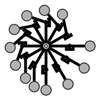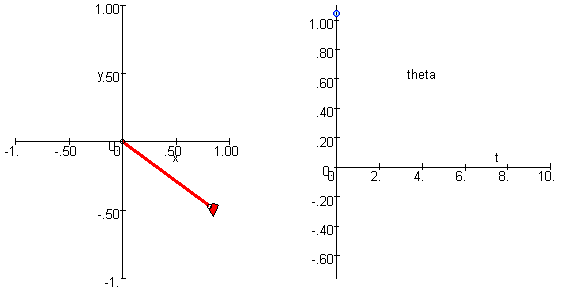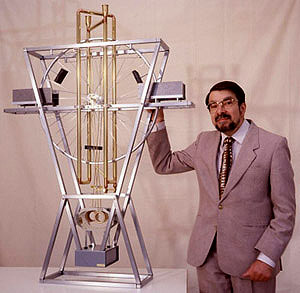

 |
PERPETUAL MISTAKES! |  |
As a physics professor at one of the proverbial Enormous State Universities, roughly once per year I hear the story of a different, wonderful machine. This machine might be located in some state in the good old U.S.A., or it might be in Canada, Australia, South Africa, Europe, Russia, you name it. The “inventor” will be no one I ever heard of, and no scientist--- he generally will have had no scientific training of any kind. The machine always has a name, but the name generally is meaningless. The machine, if it works, will “eliminate poverty and pollution, make the deserts bloom, bring electricity and technology to the meanest jungle village,” etc., etc., etc. The machine is always another new manifestation of the perpetual motion folly, and the outcome of the new story is invariably the same old outcome: all the investors lose everything that they invested, and the deserts remain bloomless.
``Inventors'' tend to exhibit three main types of perpetual motion machines. Type 1 doesn't do anything but sit there, and never will, but the “inventor” is sure the problem is minor. With a little extra money for some of those new teflon bearings, or whatever, why, that sucker will be running up a storm. The “inventor” of such a machine is generally a sincere dolt, ignorant of virtually every aspect of the world he lives in except techniques of wringing money out of investors.
Type 2 machines run impressively on tabletops, because they have a well-hidden source of power. The ”inventors” of such machines are generally predatory con-men who will have some totally different scam, some totally different name, and some totally different address, five years from now.
Type 3 machines have a clearly visible source of power, usually a pile of batteries, but the “inventor” claims the batteries are just there to “overcome friction” or something, and the machine is putting out much more energy than it is taking in from the batteries. Yep. “Inventors” of such machines generally manifest sincere stupidity mixed in a highly complex way with a cold and shrewd appreciation of the endless gullibility and greed of investors.
The “inventors” generally don't like the term perpetual motion. No, what they offer these days is a “free energy” or “zero point energy” or “vacuum energy” machine. However, what all the “inventors” are claiming is that they can get something for nothing. If the claim refers to money, they are 100% truthful. If their claim refers to energy, they are 100% untruthful. We'll see why.
One might have expected interest in perpetual motion to dry up gradually during the latter half of the 19th Century as Sir James Joule established the Law of Conservation of Energy as one of the great generalizations of nature, and the work of Clausius, Carnot, Boltzmann, Gibbs and many others led to a clear understanding of all the ins and outs of what we call the 2nd Law of Thermodynamics. Of course, the reverse was true. The latter half of the 19th Century was one of the golden ages of perpetual motion scams.
 > >
First Law--- a pendulum impossibly isolated from the rest of the universe would maintain a constant total energy of oscillation forever, thus oscillate with the same maximum amplitude forever. But its amplitude of oscillation could never increase. First Law--- You can't win. |

Second Law--- the coupling between the pendulum and the rest of the universe inevitably and eventually reduces the pendulum's total energy of oscillation to zero. The original energy is still present, but in the form of random molecular kinetic and potential energies. Second Law--- You can't even break even. |
Yet about 25 to 30 years into the 20th Century, physicists were finding that Conservation of Energy rested on a more solid foundation than anyone could have dreamed. Every known physical law is consistent with Conservation of Energy. As the new laws of quantum physics became clear, it also became clear that the three great conservation laws, for energy, momentum and angular momentum, underlay all the processes of the quantum realm, just as they do the processes of the classical realm. In short, if anyone had really been able to demonstrate a perpetual motion machine, every known description of every known physical process at every known level and scale of nature would have to be wrong. Which is more likely, that everything physicists have confirmed about nature in four centuries is all wrong, or that one shady individual with no background in science, but with a demonstrated mastery of showmanship, is seducing the suckers as effectively now as he has done so many times in the past?
Suppose I offer you the following bet: if the sun does not come up tomorrow morning, I'll pay you any stated amount. If the sun does come up, you pay me the same amount. I doubt you would take that bet, because each morning you'd be paying out to me! Those who invest in machines that are supposed to have more energy output than they have energy input plus decrease in internal energy are betting, in just this way, that the sun will not rise. They are betting that all the processes of nature will suddenly cease to operate as they do operate. This is not a bet that the investor is going to win. Not only inventors, but also investors, are not just science-illiterate, they are nature-illiterate.
 > >
First Law--- a bouncing ball whose total energy impossibly never changes. But it doesn't bounce higher on each successive bounce, even so! You can't win. |
Second Law--- what any real ball does. Eventually it will come to rest. You can't even break even. |
The great mathematician Emmy Nöther during the early 20th Century showed why the three great conservation laws serve as the underpinning of all of physics and of all processes in nature. If one point in time is as good as any other point, the total energy of an isolated process will always remain unchanged. If one point in space is as good as any other point, the total momentum of an isolated process will always remain unchanged. If one orientation in space is as good as any other orientation, the total angular momentum of an isolated process will always remain unchanged. In short, Nöther found that the conservation laws follow directly from the fact that space-time provides a “level playing field” for the processes of nature.
A universe in which perpetual motion machines worked would be very different from the universe we actually live in. In the perpetual motion universe, gravity might disappear every day at 9 AM local time, for 10 minutes, having its normal strength otherwise. The earth might spontaneously stop and then re-start rotating, and thus the sun fail to rise, one day per month. In the northeast corner of your bedroom, electromagnetic forces might have 10 times their normal strength, so that states of matter which do not exist anywhere else in the universe would be perfectly stable there.
With the state of public education being what it is, perpetual motion “inventors” have no trouble finding investors; they also have no trouble finding sympathetic supporters in the communications media; they also have little or no trouble with judges, juries, and state and federal legislators and legislatures. More than one U.S. patent has been awarded to such a bogus machine, and one contemporary “inventor” in a southern state proudly exhibits testimonials concerning the wonders of his type 3 machine, signed by more than 30 engineers and “educators.”
In his 1977 review of centuries of perpetual motion efforts, engineer Arthur Ord-Hume notes that not only do such efforts invariably end in hopeless failure, but that no incidental or serendipitous benefits have ever emerged from all the utterly wasted effort. He concludes, “There must be something in the make-up of the perpetual motionist which, while urging him on in his quest for the impossible, encourages him not to deviate from the well-trodden path to certain failure.” In all-too-many cases the very tangible “encouragement” is the influx of hundreds of thousands of dollars from deluded investors.

For convenient Internet writeups on perpetual motion machines and their generally crazed or ignorant inventors, click Phact, or Jim Loy, or Bob, or Unworkable Devices Museum or Perpetuum, or History of Perpetual Motion Machines. Keep up with the latest “free energy” crackpots here. The Steorn “Motor” has remained motionless at every public demonstration to date (August, 2007). The Minato “Motor”. Notes for a college course on perpetual motion versus physics.
 |
When you wake up one morning and find that your “Executive Toy,” aka Newton's Pendula, when once started continues to operate forever with the same maximum speed and amplitude, you will know you have waked up in a new universe nothing like our own. |
This material originally appeared in the Internet magazine Baudeville in 1995.

The typical perpetual motion machine looks superficially impressive and the "inventor" always looks (superficially anyway) like a hick. |

A conceptual design for an impossible machine making use of the well-known rising of water up into a very thin tube. Without knowing much physics, you can still see that it can't work even conceptually. |